
A cherry is the fruit of many plants of the genus Prunus, and is a fleshy drupe.

An apricot is a fruit, or the tree that bears the fruit, of several species in the genus Prunus.

A plum is a fruit of some species in Prunus subg. Prunus. Dried plums are most often called prunes, though in the United States they may be just labeled as 'dried plums', especially during the 21st century.

Prunus is a genus of trees and shrubs, which includes the fruits plums, cherries, peaches, nectarines, apricots, and almonds.
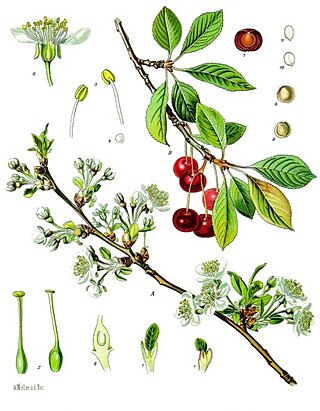
Prunus cerasus is a species of Prunus in the subgenus Cerasus (cherries), native to much of Europe, North Africa and West Asia. It is closely related to the sweet cherry, but has a fruit that is more acidic. Its sour pulp is edible.

The cherry blossom, also known as a Japanese cherry or Sakura, is the flower of trees in the genus Prunus or the Prunus subgenus Cerasus. Wild species of the cherry tree are widely distributed, mainly in the Northern Hemisphere. They are common in East Asia, especially in Japan. They generally refer to ornamental cherry trees, not cherry trees grown for their fruit. The cherry blossom is considered the national flower of Japan.
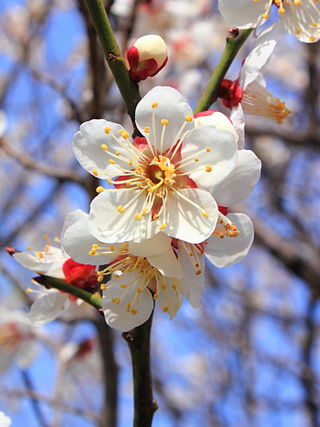
Prunus mume is a Chinese tree species classified in the Armeniaca section of the genus Prunus subgenus Prunus. Its common names include Chinese plum,Japanese plum, and Japanese apricot. The flower, long a beloved subject in the traditional painting and poetry of Sinospheric countries, is usually called plum blossom. This distinct tree species is related to both the plum and apricot trees. Although generally referred to as a plum in English, it is more closely related to the apricot. In East Asian cuisine, the fruit of the tree is used in juices, as a flavouring for alcohol, as a pickle, and in sauces. It is also used in traditional medicine.
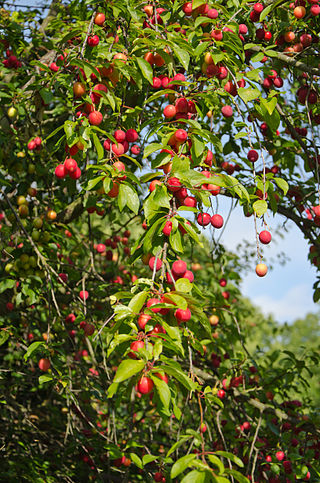
Prunus cerasifera is a species of plum known by the common names cherry plum and myrobalan plum. It is native to Southeast Europe and Western Asia, and is naturalised in the British Isles and scattered locations in North America. Also naturalized in parts of SE Australia where it is considered to be a mildly invasive weed of bushland near urban centers.

Prunus serotina, commonly called black cherry, wild black cherry, rum cherry, or mountain black cherry, is a deciduous tree or shrub of the genus Prunus. Despite being called black cherry, it is not very closely related to the commonly cultivated cherries such as sweet cherry, sour cherry and Japanese flowering cherries which belong to Prunus subg. Cerasus. Instead, P. serotina belongs to Prunus subg. Padus, a subgenus also including Eurasian bird cherry and chokecherry. The species is widespread and common in North America and South America.
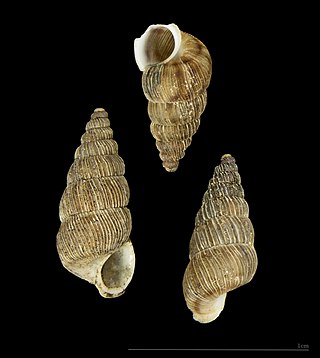
Cochlostomatinae are a family of small land snails which have opercula and gills. These are terrestrial gastropod mollusks in the superfamily Cyclophoroidea.

Anacampsis is a worldwide genus of moth with most found in the nearctic and neotropical regions. It is in the family Gelechiidae. The larvae feed on a range of deciduous trees and shrubs in a rolled or folded leaf, or spun shoot.

Prunus domestica is a species of flowering plant in the family Rosaceae. A deciduous tree, it includes many varieties of the fruit trees known as plums in English, though not all plums belong to this species. The greengages and damsons also belong to subspecies of P. domestica.

Prunus avium, commonly called wild cherry, sweet cherry, gean, or bird cherry is a species of cherry, a flowering plant in the rose family, Rosaceae. It is native to Europe, Anatolia, Maghreb, and Western Asia, from the British Isles south to Morocco and Tunisia, north to the Trondheimsfjord region in Norway and east to the Caucasus and northern Iran, with a small isolated population in the western Himalaya. The species is widely cultivated in other regions and has become naturalized in North America and Australia.

Anacampsis scintillella is a moth of the family Gelechiidae. It is found in most of Europe, except Ireland, Great Britain, the Netherlands, Norway, Finland, most of the Baltic region and Poland.

Anacampsis temerella is a moth of the family Gelechiidae. It is found in most of Europe, except Belgium, Switzerland, the Iberian Peninsula and the Balkan Peninsula.
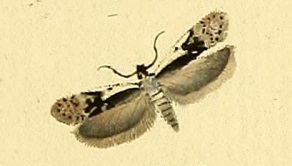
Anacampsis blattariella, the birch sober, is a moth of the family Gelechiidae. It is found in most of Europe, except Ireland, the Iberian Peninsula and most of the Balkan Peninsula.

Anacampsis timidella is a moth of the family Gelechiidae. It is found in most of Europe, except Ireland, Great Britain, the Benelux, Denmark, Fennoscandia, the Baltic region, Slovenia and Bulgaria.
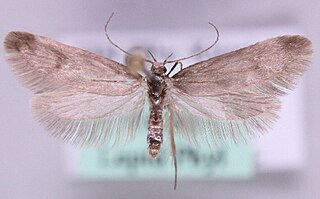
Denisia obscurella is a moth of the family Oecophoridae. It was described by Wilhelm Brandt in 1937. It is found in Scandinavia and northern Russia.
Anacampsis innocuella, the dark-headed aspen leafroller moth, is a moth of the family Gelechiidae. It was described by Philipp Christoph Zeller in 1873. It is found in North America, where it has been recorded from Alabama, British Columbia, Illinois, Indiana, Maine, Mississippi, New York, Nova Scotia, Ohio, Oklahoma, Ontario, Quebec and Vermont.
Anacampsis solemnella is a moth of the family Gelechiidae. It was described by Hugo Theodor Christoph in 1882. It is found in Japan and the Russian Far East.















